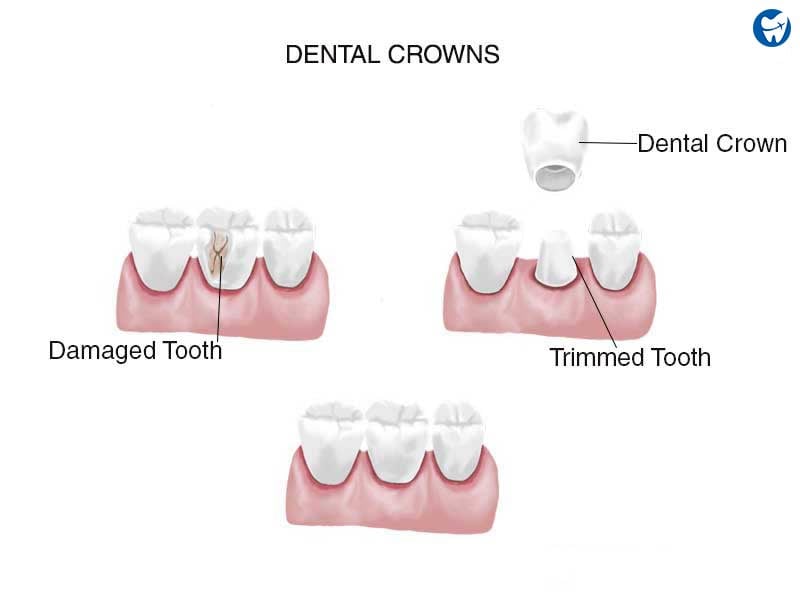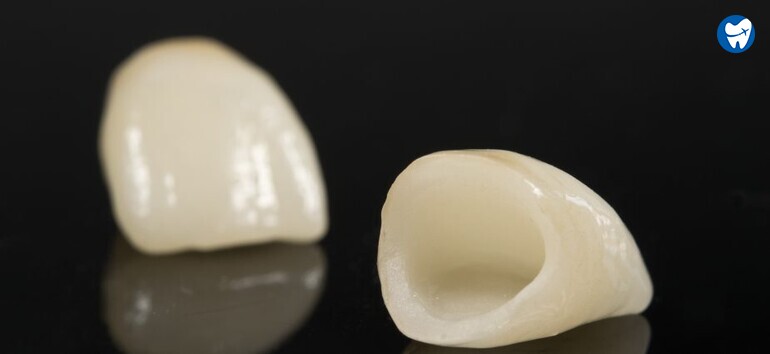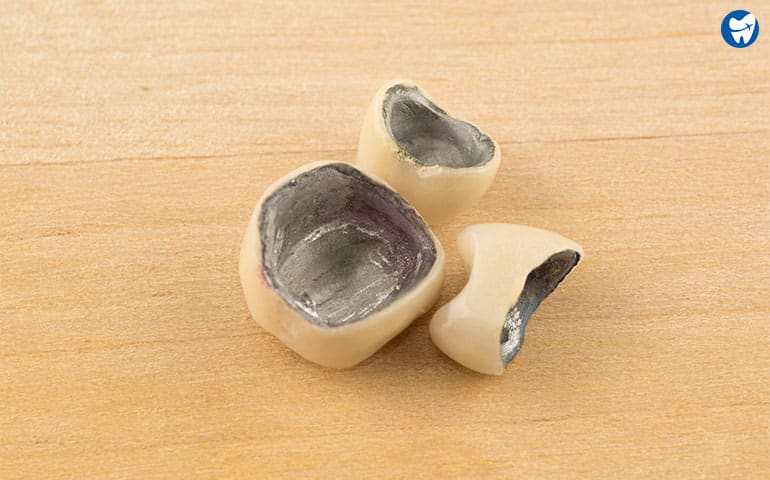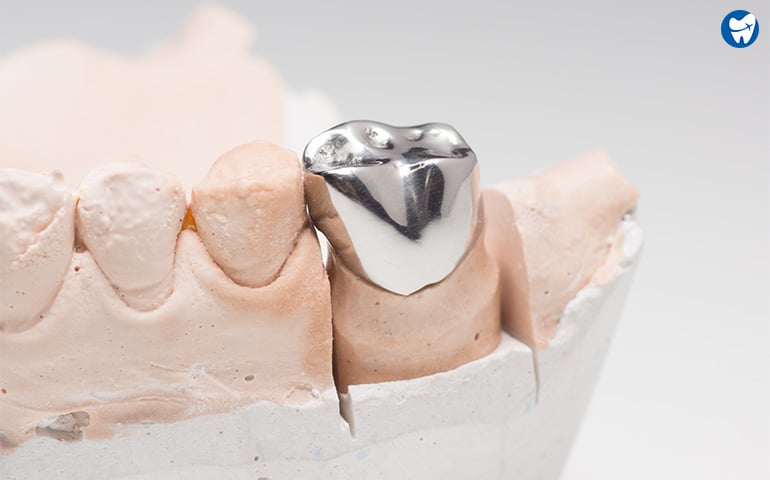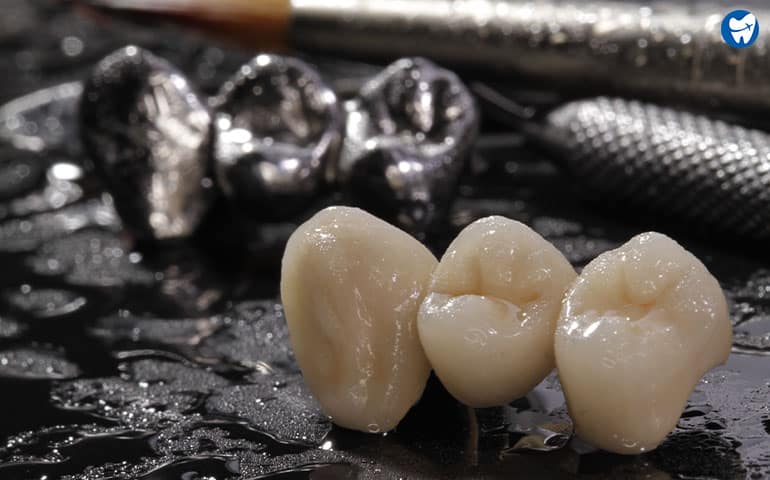Before you opt for low cost dental crowns abroad, it is important to know: what is a dental crown? A dental crown is a cover or cap that is put on top of your damaged teeth to restore their normal shape, size, and function.
Continue reading the article to know more.
Most commonly, you may need crowns if you have a cavity that is too large for a filling, after a root canal treatment or if you have a cracked or worn down tooth.
Dental Crown Procedure
Dental Crown Procedure
The dental crown procedure is generally carried out in 2 visits. In the first visit, the general examination, tooth preparation, material, and shade selection are carried out.
Till the fabrication of the permanent crown, a temporary crown is placed for the patient’s comfort.
Then during the second visit, the permanent crown is finished, adjusted, and placed.
Tooth Preparation
- The original tooth is trimmed down and prepared. It has to fit inside the new covering.
- It is a crucial step to reduce the bulkiness of the crown.
Impressions
- Impressions of the prepared tooth, the arch, and the opposing arch are taken.
- These are sent to the lab for making the permanent crown.
Temporary Crown Placement
- An temporary crown is cemented till the permanent crown gets fabricated.
- It is cemented using temporary cement.
- It protects the trimmed tooth from chipping and enables patient comfort while chewing.
Crown Preparation
- CAD/CAM (Computer-Aided Design/Manufacturing) technology gives a precise fit and unmatched look to every crown.
Cementation
- During the second visit, the temporary crown is removed.
- Following which the dentist permanently cements the crown to the tooth.
- Before cementation, the crown is checked for fit and bite.
- In addition to this, the rough margins are smoothened and polished.
Same-Day Crowns
With recent technological advances, it is possible to get same-day crowns as well. After the tooth preparation, digital scans are made using CEREC.
The crown is then designed on the computer and fabricated using a milling machine.
Lastly, the crown is cemented on the trimmed tooth. Within a few hours, you are good to go with a brand new set of dental crowns.
Post and Core is one of the additional procedures that may need to be done during the treatment.
If your tooth is irreversibly damaged and very less tooth structure is left, a post or a pin is placed inside the tooth.
It lays the foundation on which a firm filling is done, which is the core. The core acts as a prepared tooth.
On this post and core build-up, a crown is placed. Post and cores have an acceptable long-term survival time. The mean survival time was 13.5 years. [1]
Types of Dental Crowns
Crowns are made from several types of materials. To decide which material to use for your crown, your dentist will consider many factors, such as:
- The tooth’s location and function
- Your preference
- The amount of tooth that shows when you smile
The three types of crowns are all-porcelain, all-metal, and porcelain fused to metal (PFM).
All-Ceramic/Porcelain Crowns
- Made entirely out of ceramic material.
- Advantage: Most aesthetic looking as they imitate the natural tooth enamel color.
- Great for those who are allergic to metal crowns.
- Disadvantage: Cautious placement in back teeth as they are fragile. [2]
- Placement: Because of their aesthetics, all-ceramic crowns are a popular choice.

Porcelain crowns
Porcelain-Fused-to-Metal Crowns
- It consists of a metal tooth crown topped with a thin layer of porcelain.
- Advantage: The metal layer underneath the crown makes it durable. [3]
- Disadvantage: If the gums recede over the years, the metal lining becomes visible. [4]
- The porcelain layer may crack or chip off with extremely high forces.
- Placement: Used in areas where high strength is required, for instance, the molars and premolars. Molars are the back teeth, and premolars are the teeth between canine and molars.

PFM crowns
All-Metal Crowns
- Two varieties: gold alloys and base metal alloys.
- Advantage: Don’t fracture, rarely chip, and last for a long time. Moreover, gold has the same hardness as enamel. Hence, will not wear down the opposing tooth.
- Require the removal of the least amount of healthy tooth structure before fitting.
- Disadvantage: Least aesthetic of all types.
- Placement: Suitable for the back teeth that are out of sight.
Usually, your dentist will recommend porcelain fused to a metal crown for your teeth. Mainly due to the strength and durability they provide.
Even though they were used successfully for years on front teeth, all-porcelain /ceramic/E-MAX crowns have become the more aesthetic option.
All-metal crown
Zirconium and E-MAX Crowns
- Currently, the most recommended dental crowns.
- These are all-ceramic crowns that are popular due to their aesthetic appearance and comfortable fit.
- They are the closest color match to your natural teeth.
- Zirconium crowns tend to have a more solid-color look and are stronger [5] than Emax, so they are better for back teeth.
- Emax crowns have closer shade matching to natural teeth hence are better for front teeth.
- They are also lighter and thinner, which means less of your tooth is required to be removed for the crowns to fit.
- For bruxers, people who grind their teeth during the day and night, these crowns are a popular choice due to their high strength. [6]
- The disadvantages of these crowns are that they are costly. In addition, the high strength makes it difficult to adjust if required.

E-max crowns
Dental Crowns Cost Abroad
In the United States, a crown costs $1,100 – $2,000 depending on the material.
However, in dental tourism destinations like Costa Rica, Thailand, and Mexico, dental crowns are cheap, approximately between $300 – $650.
A zirconium crown will cost around $1000 – $2000 in the U.S. without dental insurance. In contrast, zirconium dental crowns in Mexico start from $450.
Similarly, in Costa Rica, it will cost you around $400 – $450, which is half of the price in the U.S. and Canada.
Dental Crowns Cost Abroad (In USD)
| Dental Crown | Mexico | Costa Rica | Colombia | Thailand | USA |
|---|---|---|---|---|---|
| All Porcelain Crown | $420 | $395 | $490 | $500 | $1,800 |
| Porcelain Fused to Metal Crown | $395 | $395 | $450 | $300 | $1,100 |
| Zirconia Crown | $450 | $450 | $600 | $500 | $2,000 |
| E-Max Porcelain Crown | $470 | $450 | $500 | $650 | $2,000 |
| All-Ceramic Crown | $420 | $410 | $590 | $500 | $1,500 |
| All-Ceramic Bridge* | $1,260 | $1,230 | $1,770 | $1,500 | $4,500 |
| Porcelain fused to Metal Bridge* | $1,200 | $1,200 | $1,350 | $900 | $3,300 |
| *3 Crown Bridge | |||||
If you head to Thailand, you can get dental crowns at A$450 – A$950, half the price of what you would have to pay in the U.K, Australia, or New Zealand.
Dental Crowns Prices Abroad (In AUD)
| Type of Dental Crown | Thailand | Vietnam | Australia | |
|---|---|---|---|---|
| All Porcelain Crown | $705 | $370 | $2,600 | |
| Porcelain Fused to Metal Crown | $430 | $155 | $2,100 | |
| Zirconia Crown | $705 | $285 | $2,800 | |
| E-Max Porcelain Crown | $920 | $425 | $2,800 | |
| All-Ceramic Crown | $705 | $370 | $2,350 | |
| All-Ceramic Bridge* | $2,115 | $1,110 | $7,000 | |
| Porcelain fused to Metal Bridge* | $1,290 | $465 | $6,200 | |
| *3 Crown Bridge | ||||
These destinations provide affordable dental treatments. Also, there is an added advantage of an overseas vacation.
It is time to make use of holidays for dental treatment.
Low Cost Dental Crowns Abroad (In GBP)
| Type of Dental Crown | Thailand | Turkey | U.K. | |
|---|---|---|---|---|
| All Porcelain Crown | £355 | £270 | £890 | |
| Porcelain Fused to Metal Crown | £215 | £205 | £605 | |
| Zirconia Crown | £355 | £260 | £1065 | |
| E-Max Porcelain Crown | £460 | £270 | £1065 | |
| All-Ceramic Crown | £355 | £270 | £710 | |
| All-Ceramic Bridge* | £1065 | £810 | £2150 | |
| Porcelain fused to Metal Bridge* | £640 | £615 | £1810 | |
| *3 Crown Bridge | ||||
An E-Max porcelain crown would cost you £450 and £270 in Thailand and Turkey, respectively.
In contrast, the same in the U.K. is priced at £1065.
Affordable crowns abroad & a splendid vacation!
Save ~ 50%Advantages and Disadvantages of Dental Crowns
Before opting for dental crowns, it is crucial to outweigh the pros and cons of the procedure.
Listed below are some of the advantages and disadvantages of dental crowns.
Advantages of Dental Crowns
- Recent advances make it possible to match the color of natural teeth and crowns thoroughly. Hence, the biggest advantage of crowns is the natural-looking results.
- Crowns provide protection and support for your damaged teeth.
- Since crowns are custom fit, they feel like your original tooth inside your mouth. Initially, the crown may feel a little foreign. However, this will only last for a few days.
- They are long-lasting replacements. With optimal dental care and regular visits to the dentists, they can last you decades.
Disadvantages of Dental Crowns
- The main disadvantage of crowns is that they can chip.
- The teeth undergo irreversible trimming to fit the crown. It may lead to sensitivity to hot and cold food.
- Just like natural teeth, crowns are susceptible to fractures and gum disease.
- In rare cases, the cement may dissolve, and crowns may become loose. The same crowns can be easily re-cemented back.
A dental crown can stabilize other prostheses, such as a dental bridge or denture. For example, the bridge can be fixed and held firmly in place by the crowns.
Top Destinations For Dental Crowns Abroad
Before selecting a destination overseas for cheap dental crowns, it is essential to pick the correct provider.
Choosing the wrong provider may lead to poor dental work.
Here is a checklist for when you are selecting a clinic for low-cost dental crowns abroad:
✅ The clinic should provide the treatment that you require.
✅ Registration of the clinic with national organizations is mandatory.
✅ The clinic must possess international accreditations.
✅ Check for the qualifications and experience of the dentist.
✅ Find out if the dentists have undergone any international training.
✅ Learn about the sterilization and sanitization protocols followed by the clinic.
✅ Ask about the warranties offered by the clinic on dental procedures.
✅ Lastly, find out if the staff speaks English. If not, are there any translators available?
We hand-pick the best clinics for the safety of our patients.
Our clinics comply with the checklist above to ensure the best dental service for you!
Which is the Best Country for Dental Crowns?
Mexico, Thailand, Turkey, Costa Rica, Colombia, Spain, Poland, India, Romania, Vietnam, Bulgaria, and Hungary are some of the top destinations for dental tourism.
These locations provide you with low cost and high quality dental crowns.
Contact us for more information on low-cost dental crowns abroad.
DentaVacation provides you with hand-picked clinics for your safety and comfort.
Dental Crowns FAQ
The longevity of a dental crown depends on the material used. It also depends on oral hygiene.
Proper oral hygiene and regular visits to the dentist can make your crown last for decades.
The average lifespan for well-maintained crowns is 5-15 years. Metal crowns may last longer.
Yes, like natural teeth, crowns can discolor with time. However, their level of staining is usually minimal.
The staining is lesser than your natural teeth, and it can be polished out if needed.
Some of the most common dental crown problems are chipping and fractures. To maintain your crowns:
- Brush your crowns, like your teeth, gently twice a day.
- Flossing around the crown is essential to prevent food lodgement.
- Moderate the consumption of teeth-staining substances like coffee, tobacco, and red wine.
- Wear a mouth guard if you bite or clench your teeth often.
- Avoid sticky and hard foods, as they can stick to your crowns and pull them free.
The treatment requires two trips to the dental clinic.
During the first visit, your dental team will prepare the tooth, take the impressions, and note the shade of your tooth.
Additionally, an interim crown is fabricated and attached to the tooth using temporary cement.
This is done to protect the trimmed tooth and for the ease of chewing.
In the second visit, your dentist will fit the permanent crown. There are usually about 3-4 days (at max) between appointments.
Some clinics can deliver crowns on the same day as tooth preparation using a CAD/CAM machine.
The tooth is prepared, scanned, designed on the computer, and milled in the office itself.
This saves time and removes the additional step of temporary crown placement.
No. You will be given a local anesthetic to numb the area for the procedure.
Your dentist will give you a temporary crown to use the tooth while waiting for the permanent crown to be made.
However, you should avoid eating sticky or hard food.
They could remove the crown as the temporary cement is weaker than the one used to bond the permanent tooth.
Typically, the cost of replacing a crown is the same as a new one.
This is because your dentist’s expenses and time taken are roughly the same.
No, it does not. However, as long as there is a good seal between the cement and the tooth, it remains protected.
Sometimes leakage can occur over time, and the cement wears away. Due to this, the tooth can get decayed.
Additionally, the crown does not protect the uncovered portion of the tooth or root near the gum line.
Hence, it is essential to clean and brush the crowned tooth just like any normal tooth.
As they too are susceptible to decay and gum disease.
Yes, extraction is a cheaper alternative in the short run.
However, once you get an extraction you will have to replace the area with an implant or a removable denture.
Get quality dentistry @ an unbelievable price!
Get in touch
